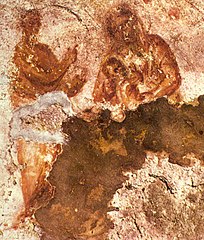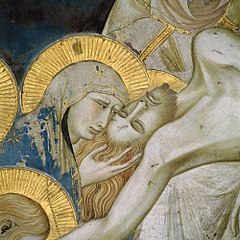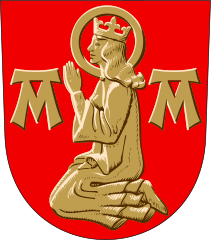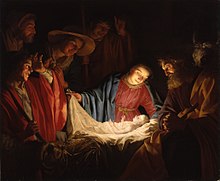Mary, mother of Jesus
Mary | |
|---|---|
| Spouse | Joseph |
| Children | Jesus |
| Parent(s) | Joachim and Anne (according to some apocryphal writings) |
Mary
She has the highest position in Islam among all women and is mentioned numerous times in the Quran, including in a chapter named after her. [7][8][9]
The
The multiple forms of
Names and titles

| Part of a series of articles on |
| Mother of Jesus |
| Chronology |
|---|
|
| Marian perspectives |
|
|
| Catholic Mariology |
|
|
| Marian dogmas |
|
|
| Mary in culture |
Mary's name in the original manuscripts of the New Testament was based on her original
comes from the Greek Μαρία, a shortened form of the name Μαριάμ. Both Μαρία and Μαριάμ appear in the New Testament.In Christianity
In Christianity, Mary is commonly referred to as the Virgin Mary, in accordance with the belief that the Holy Spirit impregnated her, thereby conceiving her first-born son Jesus miraculously, without sexual relations with her betrothed Joseph, "until her son [Jesus] was born".[18] The word "until" has inspired considerable analysis on whether Joseph and Mary produced siblings after the birth of Jesus or not.[d] Among her many other names and titles are the
Titles in use vary among
The three main titles for Mary used by the Orthodox are Theotokos (Θεοτόκος or "God-bearer"),
The title Theotokos, which means "God-bearer," was recognized at the Council of Ephesus in 431.[25][26] The direct equivalents of title in Latin are Deipara and Dei Genitrix, although the phrase is more often loosely translated into Latin as Mater Dei ("Mother of God"), with similar patterns for other languages used in the Latin Church. However, this same phrase in Greek (Μήτηρ Θεοῦ), in the abbreviated form ΜΡ ΘΥ, is an indication commonly attached to her image in Byzantine icons. The Council stated that the Church Fathers "did not hesitate to speak of the holy Virgin as the Mother of God".[27][28][29]
Some Marian titles have a direct scriptural basis. For instance, the title "Queen Mother" has been given to Mary, as she was the mother of Jesus, sometimes referred to as the "King of Kings" due to his ancestral descent from King David.[30][31][32][33][34] This is also based on the Hebrew tradition of the "Queen-Mother," the Gebirah or "Great Lady."[35][36] Other titles have arisen from reported miracles, special appeals, or occasions for calling on Mary.[e]
In Islam
In
Life in ancient sources
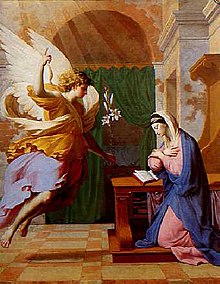
New Testament
The
The earliest New Testament account of Mary is in the
Mary is mentioned several times in the canonical Gospels and the Acts of the Apostles:
- The Gospel of Luke mentions Mary the most often, identifying her by name twelve times, all of these in the infancy narrative (Luke 1:27–2:34).[48]
- The Gospel of Matthew mentions her by name five times, four of these (1:16, 18, 20: 2:12)[49] in the infancy narrative and only once (Matthew 13:55)[50] outside the infancy narrative.
- The Gospel of Mark names her once (Mark 6:3)[51] and mentions Jesus' mother without naming her in Mark 3:31–32.[52]
- The wedding at Cana (John 2:1–12).[53] The second reference has her standing near the cross of Jesus together with Mary Magdalene, Mary of Clopas (or Cleophas), and her own sister (possibly the same as Mary of Clopas; the wording is semantically ambiguous), along with the "disciple whom Jesus loved" (John 19:25–26).[54] John 2:1–12[53] is the only text in the canonical gospels in which the adult Jesus has a conversation with Mary. He does not address her as "Mother" but as "Woman". In Koine Greek (the language that the Gospel of John was composed in), calling one's mother "Woman" was not disrespectful, and could even be tender.[55] Accordingly, some versions of the Bible translate it as "Dear woman".[56]
- In the Acts of the Apostles, Mary and the brothers of Jesus are mentioned in the company of the eleven apostles who are gathered in the upper room after the Ascension of Jesus (Acts 1:14).[57]
In the Book of Revelation, also part of the New Testament, the "woman clothed with the sun" (Revelation 12:1, 12:5–6)[58] is sometimes identified as Mary.
Genealogy
The New Testament tells little of Mary's early history. The Gospel of Matthew does give a genealogy for Jesus by his father's paternal line, only identifying Mary as the wife of Joseph. John 19:25[59] states that Mary had a sister; semantically it is unclear if this sister is the same as Mary of Clopas, or if she is left unnamed. Jerome identifies Mary of Clopas as the sister of Mary, mother of Jesus.[60] According to the early 2nd century historian Hegesippus, Mary of Clopas was likely Mary's sister-in-law, understanding Clopas (Cleophas) to have been Joseph's brother.[61]
According to the writer of Luke, Mary was a relative of
Annunciation
Mary resided in "her own house"
The angel Gabriel announced to her that she was to be the mother of the promised Messiah by conceiving him through the Holy Spirit, and, after initially expressing incredulity at the announcement, she responded, "I am the handmaid of the Lord. Let it be done unto me according to your word."[69][f] Joseph planned to quietly divorce her, but was told her conception was by the Holy Spirit in a dream by "an angel of the Lord"; the angel told him to not hesitate to take her as his wife, which Joseph did, thereby formally completing the wedding rites.[70][71]
Since the angel Gabriel had told Mary that Elizabeth—having previously been barren—was then miraculously pregnant,[72] Mary hurried to see Elizabeth, who was living with her husband Zechariah in "the hill country..., [in] a city of Juda". Mary arrived at the house and greeted Elizabeth who called Mary "the mother of my Lord", and Mary spoke the words of praise that later became known as the Magnificat from her first word in the Latin version.[73] After about three months, Mary returned to her own house.[74]
Birth of Jesus
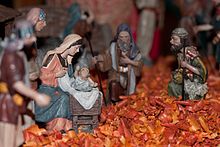
According to the
After Mary continued in the "
According to the gospel of Matthew, magi coming from Eastern regions arrived at Bethlehem where Jesus and his family were living, and worshiped him. Joseph was then warned in a dream that King Herod wanted to murder the infant, and the family fled by night to Egypt and stayed there for some time. After Herod's death in 4 BC, they returned to Nazareth in Galilee, rather than Bethlehem, because Herod's son Archelaus was the ruler of Judaea.[88]
Mary is involved in the only event in Jesus' adolescent life that is recorded in the New Testament. At the age of 12, Jesus, having become separated from his parents on their return journey from the Passover celebration in Jerusalem, was found in the Temple among the religious teachers.[89]: p.210 [90]
Ministry of Jesus
Mary was present when, at her suggestion, Jesus worked his first miracle during a
The hagiography of Mary and the Holy Family can be contrasted with other material in the Gospels. These references include an incident which can be interpreted as Jesus rejecting his family in the New Testament: "And his mother and his brothers arrived, and standing outside, they sent in a message asking for him [...] And looking at those who sat in a circle around him, Jesus said, 'These are my mother and my brothers. Whoever does the will of God is my brother, and sister, and mother'."[96][97]
Mary is also depicted as being present in a group of women at the crucifixion standing near the disciple whom Jesus loved along with Mary of Clopas and Mary Magdalene,[54] to which list Matthew 27:56[98] adds "the mother of the sons of Zebedee", presumably the Salome mentioned in Mark 15:40.[99]
After the Ascension of Jesus
In Acts 1:12–26,
From this time, she disappears from the biblical accounts, although it is held by Catholics that she is again portrayed as the heavenly woman in the Book of Revelation.[101]
Her death is not recorded in the scriptures, but Orthodox tradition, tolerated also by Catholics, has her first dying a natural death, known as the Dormition of Mary,[102] and then, soon after, her body itself also being assumed (taken bodily) into Heaven. Belief in the corporeal assumption of Mary is a dogma of the Catholic Church, in the Latin and Eastern Catholic Churches alike, and is believed as well by the Eastern Orthodox Church,[103][104] the Oriental Orthodox Church, and parts of the Anglican Communion and Continuing Anglican movement.[105]
Later writings
| Part of a series on |
| Christianity |
|---|
 |
According to the
Some unproven apocryphal accounts[
The earliest extant biographical writing on Mary is Life of the Virgin, attributed to the 7th-century saint Maximus the Confessor, which portrays her as a key element of the early Christian Church after the death of Jesus.[113][114][115]
Religious perspectives
Marian shrines) | |
|---|---|
| Feast | See Marian feast days |
| Attributes | Blue mantle, crown of 12 stars, pregnant woman, roses, woman with child, woman trampling serpent, crescent moon, woman clothed with the sun, heart pierced by sword, rosary beads |
| Patronage | See Patronage of the Blessed Virgin Mary |
Christian
Christian Marian perspectives include a great deal of diversity. While some Christians such as Catholics and Eastern Orthodox have well established Marian traditions, Protestants at large pay scant attention to Mariological themes. Catholic, Eastern Orthodox, Oriental Orthodox, Anglican, and Lutherans venerate the Virgin Mary. This veneration especially takes the form of prayer for intercession with her Son, Jesus Christ. Additionally, it includes composing poems and songs in Mary's honor, painting icons or carving statues of her, and conferring titles on Mary that reflect her position among the saints.[22][24][117][118]
Catholic
In the Catholic Church, Mary is accorded the title "Blessed" (beata, μακάρια) in recognition of her assumption to Heaven and her capacity to intercede on behalf of those who pray to her. There is a difference between the usage of the term "blessed" as pertaining to Mary and its usage as pertaining to a
The
For centuries, Catholics have performed acts of consecration and entrustment to Mary at personal, societal and regional levels. These acts may be directed to the Virgin herself, to the Immaculate Heart of Mary and to the Immaculate Conception. In Catholic teachings, consecration to Mary does not diminish or substitute the love of God, but enhances it, for all consecration is ultimately made to God.[124][125]
Following the growth of Marian devotions in the 16th century, Catholic saints wrote books such as Glories of Mary and True Devotion to Mary that emphasized Marian veneration and taught that "the path to Jesus is through Mary".[126] Marian devotions are at times linked to Christocentric devotions (such as the Alliance of the Hearts of Jesus and Mary).[127]
Major Marian devotions include:
Catholics place high emphasis on Mary's roles as protector and intercessor and the Catechism refers to Mary as "honored with the title 'Mother of God', to whose protection the faithful fly in all their dangers and needs".[123][133][134][135][136] Key Marian prayers include: Ave Maria, Alma Redemptoris Mater, Sub tuum praesidium, Ave maris stella, Regina caeli, Ave Regina caelorum and the Magnificat.[137]
Mary's participation in the processes of
In the 20th century, both popes John Paul II and
"It is necessary to go back to Mary if we want to return to that 'truth about Jesus Christ,' 'truth about the Church' and 'truth about man.'"[143]
There is significant diversity in the Marian doctrines attributed to her primarily by the Catholic Church. The key Marian doctrines held primarily in Catholicism can be briefly outlined as follows:
- Immaculate Conception: Mary was conceived without original sin.
- Mother of God: Mary, as the mother of Jesus, is the Theotokos (God-bearer), or Mother of God.
- Holy Spiritwhile remaining a virgin.
- Perpetual Virginity: Mary remained a virgin all her life, even after the act of giving birth to Jesus.
- Dormition: commemorates Mary's "falling asleep" or natural death shortly before her Assumption. Dormition is part of accepted Eastern Catholic theology, but not part of Roman Catholic doctrine.[144]
- Assumption: Mary was taken bodily into heaven either at, or before, her death.
The acceptance of these Marian doctrines by Roman Catholics and other Christians can be summarized as follows:[16][145][146]
| Doctrine | Church action | Accepted by |
|---|---|---|
| Virgin birth of Jesus | First Council of Nicaea, 325 | Catholics, Eastern Orthodox, Oriental Orthodox, Assyrians, Anglicans, Baptists, mainline Protestants |
Mother of God |
First Council of Ephesus , 431 |
Catholics, Eastern Orthodox, Oriental Orthodox, Anglicans, Lutherans, some Methodists |
Perpetual Virginity |
Second Ecumenical Council of Constantinople, 553Smalcald Articles, 1537 | Catholics, Eastern Orthodox, Oriental Orthodox, Assyrians, some Anglicans, some Lutherans (Martin Luther) |
| Immaculate Conception | Ineffabilis Deus encyclicalPope Pius IX, 1854 | Catholics, some Anglicans, some Lutherans (early Martin Luther) |
| Assumption of Mary | Munificentissimus Deus encyclicalPope Pius XII, 1950 | Catholics, Eastern and Oriental Orthodox (only following her natural death), some Anglicans, some Lutherans |
The title "Mother of God" (Theotokos) for Mary was confirmed by the

The Virgin birth of Jesus was an almost universally held belief among Christians from the 2nd until the 19th century.[148] It is included in the two most widely used Christian creeds, which state that Jesus "was incarnate of the Holy Spirit and the Virgin Mary" (the Nicene Creed, in what is now its familiar form)[149] and the Apostles' Creed. The Gospel of Matthew describes Mary as a virgin who fulfilled the prophecy of Isaiah 7:14,[150] The authors of the Gospels of Matthew and Luke consider Jesus' conception not the result of intercourse, and assert that Mary had "no relations with man" before Jesus' birth.[151] This alludes to the belief that Mary conceived Jesus through the action of God the Holy Spirit, and not through intercourse with Joseph or anyone else.[152]
The doctrines of the Assumption or Dormition of Mary relate to her death and bodily assumption to heaven. Roman Catholic Church has dogmatically defined the doctrine of the Assumption, which was done in 1950 by Pope Pius XII in Munificentissimus Deus. Whether Mary died or not is not defined dogmatically, however, although a reference to the death of Mary is made in Munificentissimus Deus. In the Eastern Orthodox Church, the Assumption of the Virgin Mary is believed, and celebrated with her Dormition, where they believe she died.
Catholics believe in the
The Perpetual Virginity of Mary asserts Mary's real and perpetual virginity even in the act of giving birth to the Son of God made Man. The term Ever-Virgin (Greek ἀειπάρθενος) is applied in this case, stating that Mary remained a virgin for the remainder of her life, making Jesus her biological and only son, whose conception and birth are held to be miraculous.[120][152][155] The Orthodox Churches hold the position articulated in the Protoevangelium of James that Jesus' brothers and sisters were Joseph's children from a marriage prior to that of Mary, which had left him widowed. Roman Catholic teaching follows the Latin father Jerome in considering them Jesus' cousins.
Eastern Orthodox
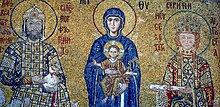
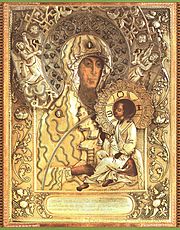
The views of the
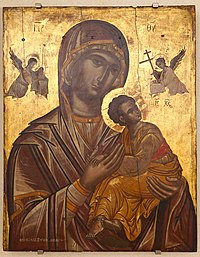
The Orthodox view Mary as "superior to all created beings", although not divine.
The
Theologians from the Orthodox tradition have made prominent contributions to the development of Marian thought and devotion.
It was necessary that the body of the one who preserved her virginity intact in giving birth should also be kept incorrupt after death. It was necessary that she, who carried the Creator in her womb when he was a baby, should dwell among the tabernacles of heaven.[164]
From her we have harvested the grape of life; from her we have cultivated the seed of immortality. For our sake she became Mediatrix of all blessings; in her God became man, and man became God.[165]
More recently, Sergei Bulgakov expressed the Orthodox sentiments towards Mary as follows:[160]
Mary is not merely the instrument, but the direct positive condition of the Incarnation, its human aspect. Christ could not have been incarnate by some mechanical process, violating human nature. It was necessary for that nature itself to say for itself, by the mouth of the most pure human being: "Behold the handmaid of the Lord, be it unto me according to Thy word."
Protestant

Protestants in general reject the veneration and invocation of the Saints.[16]: 1174 They share the belief that Mary is the mother of Jesus and "blessed among women" (Luke 1:42)[166] but they generally do not agree that Mary is to be venerated. She is considered to be an outstanding example of a life dedicated to God.[167] As such, they tend not to accept certain church doctrines such as her being preserved from sin.[168] Theologian Karl Barth wrote that "the heresy of the Catholic Church is its Mariology".[169]
Some early Protestants venerated Mary. Martin Luther wrote that: "Mary is full of grace, proclaimed to be entirely without sin. God's grace fills her with everything good and makes her devoid of all evil."[170] However, as of 1532, Luther stopped celebrating the feast of the Assumption of Mary and also discontinued his support of the Immaculate Conception.[171] John Calvin remarked, "It cannot be denied that God in choosing and destining Mary to be the Mother of his Son, granted her the highest honor."[h] However, Calvin firmly rejected the notion that Mary can intercede between Christ and man.[174]
Although Calvin and Huldrych Zwingli honored Mary as the Mother of Christ in the 16th century, they did so less than Martin Luther.[175] Thus the idea of respect and high honor for Mary was not rejected by the first Protestants; however, they came to criticize the Roman Catholics for venerating Mary. Following the Council of Trent in the 16th century, as Marian veneration became associated with Catholics, Protestant interest in Mary decreased. During the Age of the Enlightenment, any residual interest in Mary within Protestant churches almost disappeared, although Anglicans and Lutherans continued to honor her.[16]
In the 20th century, some Protestants reacted in opposition to the Catholic dogma of the
Anglican
The various churches that form the
Mary's special position within God's purpose of salvation as "God-bearer" is recognised in a number of ways by some Anglican Christians.
The Conception of the Blessed Virgin Mary is kept in the 1662 Book of Common Prayer, on 8 December. In certain
Prayers and venerative practices vary greatly. For instance, as of the 19th century, following the
The Anglican Society of Mary was formed in 1931 and maintains chapters in many countries. The purpose of the society is to foster devotion to Mary among Anglicans.[118][180] High church Anglicans espouse doctrines that are closer to Roman Catholics, and retain veneration for Mary, such as Anglican pilgrimages to Our Lady of Lourdes, which have taken place since 1963, and pilgrimages to Our Lady of Walsingham, which have taken place for hundreds of years.[181]
Historically, there has been enough common ground between Roman Catholics and Anglicans on Marian issues that in 2005, a joint statement called Mary: grace and hope in Christ was produced through ecumenical meetings of Anglicans and Roman Catholic theologians. This document, informally known as the "Seattle Statement", is not formally endorsed by either the Catholic Church or the Anglican Communion, but is viewed by its authors as the beginning of a joint understanding of Mary.[118][182]
Lutheran

Despite Martin Luther's harsh polemics against his Roman Catholic opponents over issues concerning Mary and the saints, theologians appear to agree that Luther adhered to the Marian decrees of the ecumenical councils and dogmas of the church. He held fast to the belief that Mary was a perpetual virgin and Mother of God.[183][184] Special attention is given to the assertion that Luther, some 300 years before the dogmatization of the Immaculate Conception by Pope Pius IX in 1854, was a firm adherent of that view[citation needed]. Others maintain that Luther in later years changed his position on the Immaculate Conception, which, at that time was undefined in the church, maintaining however the sinlessness of Mary throughout her life.[185][186] For Luther, early in his life, the Assumption of Mary was an understood fact, although he later stated that the Bible did not say anything about it and stopped celebrating its feast. Important to him was the belief that Mary and the saints do live on after death.[187][188][189] "Throughout his career as a priest-professor-reformer, Luther preached, taught, and argued about the veneration of Mary with a verbosity that ranged from childlike piety to sophisticated polemics. His views are intimately linked to his Christocentric theology and its consequences for liturgy and piety."[190]
Luther, while revering Mary, came to criticize the "Papists" for blurring the line between high admiration of the grace of God wherever it is seen in a human being, and religious service given to another creature. He considered the Roman Catholic practice of celebrating saints' days and making intercessory requests addressed especially to Mary and other departed saints to be idolatry.[191][192] His final thoughts on Marian devotion and veneration are preserved in a sermon preached at Wittenberg only a month before his death:
Therefore, when we preach faith, that we should worship nothing but God alone, the Father of our Lord Jesus Christ, as we say in the Creed: 'I believe in God the Father almighty and in Jesus Christ,' then we are remaining in the temple at Jerusalem. Again,'This is my beloved Son; listen to him.' 'You will find him in a manger'. He alone does it. But reason says the opposite: What, us? Are we to worship only Christ? Indeed, shouldn't we also honor the holy mother of Christ? She is the woman who bruised the head of the serpent. Hear us, Mary, for thy Son so honors thee that he can refuse thee nothing. Here Bernard went too far in his Homilies on the Gospel: Missus est Angelus.[193] God has commanded that we should honor the parents; therefore I will call upon Mary. She will intercede for me with the Son, and the Son with the Father, who will listen to the Son. So you have the picture of God as angry and Christ as judge; Mary shows to Christ her breast and Christ shows his wounds to the wrathful Father. That's the kind of thing this comely bride, the wisdom of reason cooks up: Mary is the mother of Christ, surely Christ will listen to her; Christ is a stern judge, therefore I will call upon St. George and St. Christopher. No, we have been by God's command baptized in the name of the Father, the Son, and the Holy Spirit, just as the Jews were circumcised.[194][195]
Certain Lutheran churches such as the
Methodist
Methodists do not have any additional teachings on the Virgin Mary except from what is mentioned in Scripture and the ecumenical Creeds. As such, Methodists generally accept the doctrine of the virgin birth, but reject the doctrine of the Immaculate Conception.[197] John Wesley, the principal founder of the Methodist movement within the Church of England, believed that Mary "continued a pure and unspotted virgin", thus upholding the doctrine of the perpetual virginity of Mary.[198][199] Contemporary Methodism does hold that Mary was a virgin before, during, and immediately after the birth of Christ.[200][201] In addition, some Methodists also hold the doctrine of the Assumption of Mary as a pious opinion.[202]
Nontrinitarian
In nontrinitarian groups that are also Christian mortalists, Mary is not seen as an intercessor between humankind and Jesus, whom mortalists would consider "asleep", awaiting resurrection.[208]
Jewish
The issue of the parentage of
Islamic

The Virgin Mary holds a singularly exalted place in Islam, and she is considered by the Quran to have been the greatest woman in the history of humankind. The Islamic scripture recounts the Divine Promise given to Mary as being: ""O Mary! Surely Allah has selected you, purified you, and chosen you over all women of the world" (3:42).
Mary is often referred to by Muslims by the honorific title Sayedetina ("Our Lady"). She is mentioned in the Quran as the daughter of Imran.[217]
Moreover, Mary is the only woman named in the Quran and she is mentioned or referred to in the scripture a total of 50 times.
Birth
In a narration of
Motherhood
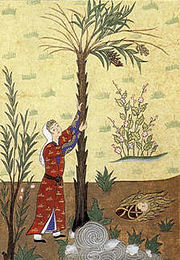
Mary was declared (uniquely along with Jesus) to be a "Sign of God" to humanity;
Mary is also called a "Chosen One";[221] a "Purified One";[221] a "Truthful one";[222] her child conceived through "a Word from God";[223] and "chosen you above the women of the worlds(the material and heavenly worlds)".[221]
The Quran relates detailed narrative accounts of Maryam (Mary) in two places, 3:35-47 and 19:16-34. These state beliefs in both the Immaculate Conception of Mary and the virgin birth of Jesus.[224][225][226] The account given in Surah Maryam 19 is nearly identical with that in the Gospel according to Luke, and both of these (Luke, Sura 19) begin with an account of the visitation of an angel upon Zakariya (Zecharias) and "Good News of the birth of Yahya (John)", followed by the account of the annunciation. It mentions how Mary was informed by an angel that she would become the mother of Jesus through the actions of God alone.[227]
In the Islamic tradition, Mary and Jesus were the only children who could not be touched by Satan at the moment of their birth, for God imposed a veil between them and Satan.[228][229] According to the author Shabbir Akhtar, the Islamic perspective on Mary's Immaculate Conception is compatible with the Catholic doctrine of the same topic.
"O People of the Book! Do not go to extremes regarding your faith; say nothing about Allah except the truth. The Messiah, Jesus, son of Mary, was no more than a messenger of Allah and the fulfilment of His Word through Mary and a spirit ˹created by a command˺ from Him. So believe in Allah and His messengers and do not say, "Trinity." Stop!—for your own good. Allah is only One God. Glory be to Him! He is far above having a son! To Him belongs whatever is in the heavens and whatever is on the earth. And Allah is sufficient as a Trustee of Affairs.
The Quran says that Jesus was the result of a virgin birth. The most detailed account of the annunciation and birth of Jesus is provided in Suras 3 and 19 of the Quran, where it is written that God sent an angel to announce that she could shortly expect to bear a son, despite being a virgin.[232]
Bahá'í Faith
The
Biblical scholars
The statement found in
Other biblical verses have also been debated; for example, the reference made by Paul the Apostle that Jesus was made "of the seed of David according to the flesh" (Romans 1:3)[244] meaning that he was a descendant of David through Joseph.[245]
Pre-Christian Rome
From the early stages of Christianity, belief in the virginity of Mary and the virgin conception of Jesus, as stated in the gospels, holy and supernatural, was used by detractors, both political and religious, as a topic for discussions, debates, and writings, specifically aimed to challenge the divinity of Jesus and thus Christians and Christianity alike.
Christian devotions
History
2nd century
Justin Martyr was among the first to draw a parallel between Eve and Mary. This derives from his comparison of Adam and Jesus. In his Dialogue with Trypho, written sometime between 155 and 167,[250] he explains:
He became man by the Virgin, in order that the disobedience which proceeded from the serpent might receive its destruction in the same manner in which it derived its origin. For Eve, who was a virgin and undefiled, having conceived the word of the serpent, brought forth disobedience and death. But the Virgin Mary received faith and joy, when the angel Gabriel announced the good tidings to her that the Spirit of the Lord would come upon her, and the power of the Highest would overshadow her: wherefore also the Holy Thing begotten of her is the Son of God; and she replied, 'Be it unto me according to thy word." And by her has He been born, to whom we have proved so many scriptures refer, and by whom God destroys both the serpent and those angels and men who are like him; but works deliverance from death to those who repent of their wickedness and believe upon Him.[251]
It is possible that the teaching of Mary as the
In accordance with this design, Mary the Virgin is found obedient, saying, "Behold the handmaid of the Lord; be it unto me according to your word." Luke 1:38 But Eve was disobedient; for she did not obey when as yet she was a virgin. ... having become disobedient, was made the cause of death, both to herself and to the entire human race; so also did Mary, having a man betrothed [to her], and being nevertheless a virgin, by yielding obedience, become the cause of salvation, both to herself and the whole human race. And on this account does the law term a woman betrothed to a man, the wife of him who had betrothed her, although she was as yet a virgin; thus indicating the back-reference from Mary to Eve,...For the Lord, having been born "the First-begotten of the dead," Revelation 1:5 and receiving into His bosom the ancient fathers, has regenerated them into the life of God, He having been made Himself the beginning of those that live, as Adam became the beginning of those who die. 1 Corinthians 15:20–22 Wherefore also Luke, commencing the genealogy with the Lord, carried it back to Adam, indicating that it was He who regenerated them into the Gospel of life, and not they Him. And thus also it was that the knot of Eve's disobedience was loosed by the obedience of Mary. For what the virgin Eve had bound fast through unbelief, this did the virgin Mary set free through faith.[254]
During the second century, the Gospel of James was also written. According to Stephen J. Shoemaker, "its interest in Mary as a figure in her own right and its reverence for her sacred purity mark the beginnings of Marian piety within early Christianity".[255]
3rd to 5th centuries
During the Age of Martyrs and at the latest in the fourth century, the majority of the most essential ideas of Marian devotion already appeared in some form – in the writings of the Church Fathers, apocrypha and visual arts. The lack of sources makes it unclear whether the devotion to Mary played a role in liturgical use during the very first centuries of Christianity.[256] In the 4th century, Marian devotion in a liturgical context becomes evident.[257]
The earliest known Marian prayer (the
The Council of Ephesus was long thought to have been held at a church in Ephesus which had been dedicated to Mary about a hundred years before.[267][268][269] Though, recent archeological surveys indicate that St. Mary's Church in Ephesus did not exist at the time of the Council or, at least, the building was not dedicated to Mary before 500.[270] The Church of the Seat of Mary in Judea was built shortly after the introduction of Marian liturgy at the council of Ephesus, in 456, by a widow named Ikelia.[271]
According to the 4th-century heresiologist
Byzantium
During the era of the Byzantine Empire, Mary was venerated as the virginal Mother of God and as an intercessor.[273]
Ephesus is a cultic centre of Mary, the site of the first church dedicated to her and the rumoured place of her death. Ephesus was previously a centre for worship of Artemis, a virgin goddess; the Temple of Artemis there is regarded as one of the Seven Wonders of the Ancient World. The cult of Mary was furthered by Queen Theodora in the 6th century.[274][275] According to William E. Phipps, in the book Survivals of Roman Religion,[276] "Gordon Laing argues convincingly that the worship of Artemis as both virgin and mother at the grand Ephesian temple contributed to the veneration of Mary."[277]
Middle Ages
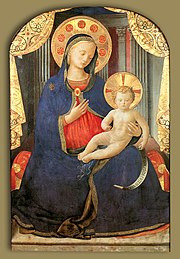
The Middle Ages saw many legends about Mary, her parents, and even her grandparents.[278] Mary's popularity increased dramatically from the 12th century,[279] linked to the Roman Catholic Church’s designation of Mary as Mediatrix.[280][281]
Post-Reformation

Over the centuries, devotion and veneration to Mary has varied greatly among Christian traditions. For instance, while Protestants show scant attention to Marian prayers or devotions, of all the saints whom the Orthodox venerate, the most honored is Mary, who is considered "more honorable than the
Orthodox theologian Sergei Bulgakov wrote: "Love and veneration of the Blessed Virgin Mary is the soul of Orthodox piety. A faith in Christ which does not include his mother is another faith, another Christianity from that of the Orthodox church."[160]
Although the Catholics and the Orthodox may honor and venerate Mary, they do not view her as divine, nor do they worship her. Roman Catholics view Mary as subordinate to Christ, but uniquely so, in that she is seen as above all other creatures.[282] Similarly, Theologian Sergei Bulgakov wrote that the Orthodox view Mary as "superior to all created beings" and "ceaselessly pray for her intercession". However, she is not considered a "substitute for the One Mediator" who is Christ.[160] "Let Mary be in honor, but let worship be given to the Lord", he wrote.[283] Similarly, Catholics do not worship Mary as a divine being, but rather "hyper-venerate" her. In Roman Catholic theology, the term hyperdulia is reserved for Marian veneration, latria for the worship of God, and dulia for the veneration of other saints and angels.[284] The definition of the three level hierarchy of latria, hyperdulia and dulia goes back to the Second Council of Nicaea in 787.[285]
Devotions to artistic depictions of Mary vary among Christian traditions. There is a long tradition of
The Anglican position towards Mary is in general more conciliatory than that of Protestants at large and in a book he wrote about praying with the icons of Mary, Rowan Williams, former archbishop of Canterbury, said: "It is not only that we cannot understand Mary without seeing her as pointing to Christ; we cannot understand Christ without seeing his attention to Mary."[118][291]
On 4 September 1781, 11 families of
Feasts
The earliest feasts that relate to Mary grew out of the cycle of feasts that celebrated the
In the 7th and 8th centuries, four more Marian feasts were established in Eastern Christianity. In the West, a feast dedicated to Mary, just before Christmas was celebrated in the Churches of Milan and Ravenna in Italy in the 7th century. The four Roman Marian feasts of Purification, Annunciation, Assumption and Nativity of Mary were gradually and sporadically introduced into England by the 11th century.[293]
Over time, the number and nature of feasts (and the associated
Differences in feasts may also originate from doctrinal issues—the
Relics
The veneration of marian
Bodily relics
As Mary's body is believed by most Christians to have been taken up into the glory of heaven, her bodily relics have been limited to hair, nails and breast milk.
According to John Calvin's 1543 Treatise on Relics, her hair was exposed for veneration in several churches, including in Rome, Saint-Flour, Cluny and Nevers.[297]
In this book, Calvin criticized the veneration of the Holy Milk due to the lack of biblical references to it and the doubts about the veracity of such relics:
With regard to the milk, there is not perhaps a town, a convent, or nunnery, where it is not shown in large or small quantities. Indeed, had the Virgin been a wet-nurse her whole life, or a dairy, she could not have produced more than is shown as hers in various parts. How they obtained all this milk they do not say, and it is superfluous here to remark that there is no foundation in the Gospels for these foolish and blasphemous extravagances.
Although the veneration of Marian bodily relics is no longer a common practice today, there are some remaining traces of it, such as the Chapel of the Milk Grotto in Bethlehem, named after Mary's milk.
Clothes
Clothes which are believed to have belonged to Mary include the
Other relics are said to have been collected during later
Few other objects are said to have been touched or given by Mary during
Places
Places where Mary is believed to have lived include the Basilica della Santa Casa in Loreto, Marche, and the House of the Virgin Mary in Ephesus.
The belief that Mary's house was in
The apparition of Our Lady of the Pillar in the first century was believed to be a bilocation, as it occurred in Spain while Mary was living in Ephesus or Jerusalem. The pillar on which she was standing during the apparition is believed to be kept in the Cathedral-Basilica of Our Lady of the Pillar in Zaragoza and is therefore venerated as a relics, as it was in physical contact with Mary.
In arts
Iconography
In paintings, Mary is traditionally portrayed in blue. This tradition can trace its origin to the Byzantine Empire, from c. 500 AD, where blue was "the colour of an empress". A more practical explanation for the use of this colour is that in Medieval and Renaissance Europe, the blue pigment was derived from the rock lapis lazuli, a stone of greater value than gold, which was imported from Afghanistan. Beyond a painter's retainer, patrons were expected to purchase any gold or lapis lazuli to be used in the painting. Hence, it was an expression of devotion and glorification to swathe the Virgin in gowns of blue. Transformations in visual depictions of Mary from the 13th to 15th centuries mirror her "social" standing within the Church and in society.[308]
Traditional representations of Mary include the crucifixion scene, called Stabat Mater.[309][310] While not recorded in the Gospel accounts, Mary cradling the dead body of her son is a common motif in art, called a "pietà" or "pity".
-
Mary nursing theInfant Jesus. Early image from the Catacomb of Priscilla, Rome, c. 2nd century
-
Our Lady of Vladimir, a Byzantine representation of the Theotokos
-
Theotokos Panachranta, from the 11th centuryGertrude Psalter
-
Chinese Madonna, St. Francis' Church, Macao
-
St Vaast Altarpiece by Jacques Daret, 1434–1435
-
Rubens, 1634
-
Virgin and Child, French (15th century)
-
Mary and Jesus, outside the Jongno Catholic Church in Seoul, South Korea.
-
Statue of Mary and Jesus at Gwanghwamun, pictured at the time of Pope Francis' visit to South Korea, 2014.
-
Mary outside St. Nikolai Catholic Church in Ystad 2021
-
A kneeling Virgin Mary pictured in the former coat of arms of Maaria
Cinematic portrayals
Mary has been portrayed in various films and on television, including:
- The Miracle (1912) color silent film of the 1911 play The Miracle, a statue of Mary, played by Maria Carmi, comes to life
- Das Mirakel (1912) silent film; a German version of the 1911 play The Miracle
- The Song of Bernadette (1943 film), played by Linda Darnell.
- The Living Christ Series (1951 non-theatrical, non-television film twelve-part series), played by Eileen Rowe.
- The Miracle of Our Lady of Fatima (1952 film), played by Virginia Gibson.
- Ben-Hur (1959 film), played by José Greci.[311]
- Das Mirakel)
- King of Kings (1961 film), played by Siobhán McKenna.[312]
- The Greatest Story Ever Told (1965 film), played by Dorothy McGuire.[313]
- Jesus of Nazareth (1977 two-part television miniseries), played by Olivia Hussey.[314]
- The Last Temptation of Christ (1988 film), played by Verna Bloom.[315]
- Mary, Mother of Jesus (1999 television film), played by Pernilla August.[316]
- Shabnam Gholikhani.[317]
- The Passion of the Christ (2004 film), played by Maia Morgenstern.[318]
- Imperium: Saint Peter (2005 television film), played by Lina Sastri.
- Color of the Cross (2006 film), played by Debbi Morgan.[319]
- The Nativity Story (2006 film), played by Keisha Castle-Hughes.[320]
- The Passion (2008 television miniseries), played by Paloma Baeza.[321][322]
- The Nativity (2010 four-part miniseries), played by Tatiana Maslany.
- Mary of Nazareth (2012 film), played by Alissa Jung.
- Son of God (2014 film), played by Roma Downey.[323]
- Mary Magdalene (2018 film), played by Irit Sheleg.[324]
- Jesus: His Life (2019 TV series), played by Houda Echouafni.[325]
- Fatima (2020 film), played by Joana Ribeiro.
Music
- Claudio Monteverdi: Vespro della Beata Vergine (1610)
- Johann Sebastian Bach: Magnificat (1723, rev. 1733)
- Franz Schubert: Ave Maria (1835)
- Charles Gounod: Ave Maria (1859)
- John Tavener: Mother and Child, setting a poem by Brian Keeble for choir, organ and temple gong (2002)
See also
- Acts of Reparation to the Virgin Mary
- Genealogy of Jesus
- History of Catholic Mariology
- Holy Name of Mary
- Marian and Holy Trinity columns
- May crowning
- Miriai; Mandaean heroine that many equate with Mary
- New Testament people named Mary
- Shrines to the Virgin Mary
Notes
- that of Jesus, and though some posit slightly different dates (such as Meier's dating of c. 7 or 6 BC)[2] general consensus places Jesus' birth in c. 4 BC,[3]thus placing Mary's birth in c. 18 BC.
- Latin: Maria; Coptic: Ⲙⲁⲣⲓⲁ, romanized: Maria
- ^ παρθένος; Matthew 1:23[10] uses the Greek parthénos, "virgin", whereas only the Hebrew of Isaiah 7:14,[11] from which the New Testament ostensibly quotes, as Almah – "young maiden". See article on parthénos in Bauercc/(Arndt)/Gingrich/Danker, A Greek-English Lexicon of the New Testament and Other Early Christian Literature.[12]
- ^ See Sabine R. Huebner's succinct analysis of the issue: "Jesus is described as the 'first-born son' of Mary in Mt 1:25 and Lk 2:7. From this wording alone we can conclude that there were later-born sons […] The family […] had at least five sons and an unknown number of daughters."[19]
- ^ This event is described by some Christians as the Annunciation.
- ^ The historicity of this census' relationship to the birth of Jesus continues to be one of scholarly disagreement; see, for example, p. 71 in Edwards, James R. (2015).[75]
- ^ Alternately: "It cannot even be denied that God conferred the highest honour on Mary, by choosing and appointing her to be the mother of his Son."[172][173]
- ^ See the following verses: 5:114, 5:116, 7:158, 9:31, 17:57, 17:104, 18:102, 19:16, 19:17, 19:18, 19:20, 19:22, 19:24, 19:27, 19:28, 19:29, 19:34, 21:26, 21:91, 21:101, 23:50, 25:17, 33:7, 39:45, 43:57, 43:61, 57:27, 61:6, 61:14, 66:12.
References
- ^ a b "Catholic Encyclopedia: St. Joseph". Newadvent.org. Archived from the original on 27 June 2017. Retrieved 30 September 2013.
- ISBN 978-0-300-14018-7.
- ISBN 978-0-14-192822-7. Archivedfrom the original on 18 April 2017. Retrieved 1 September 2022.
- ^ "Catholic Enncyclopedia: Tomb of the Blessed Virgin Mary". New Advent. Retrieved 2 January 2023.
- ^ "Tomb of Mary: Location and Significance: University of Dayton, Ohio". udayton.edu. Retrieved 2 January 2023.
- ISBN 978-0809121687. Archivedfrom the original on 17 August 2021. Retrieved 23 February 2021.
...consonant with Mary's Jewish background
- ^ Quran 3:42; cited in Stowasser, Barbara Freyer, "Mary", in: Encyclopaedia of the Qurʾān, General Editor: Jane Dammen McAuliffe, Georgetown University, Washington DC.
- ^ J.D. McAuliffe, Chosen of all women
- ^
- ^ Matthew 1:23
- ^ Isaiah 7:14
- ^ Bauercc/(Arndt)/Gingrich/Danker, A Greek-English Lexicon of the New Testament and Other Early Christian Literature, 2nd ed., University of Chicago Press, 1979, p. 627.
- ISBN 978-1-57918-355-4p. 178
- ISBN 0-8308-2569-Xp. 142
- ^ "Mary, the mother of Jesus." The New Dictionary of Cultural Literacy, Houghton Mifflin. Boston: Houghton Mifflin, 2002. Credo Reference. Web. 28 September 2010.
- ^
- ISBN 0198610602.
- ^ Matthew 1:25
- ISBN 1108470254
- ^ Fulbert of Chatres, O Beata Virgo Maria, archived from the original on 4 March 2021, retrieved 27 March 2020
- ISBN 0-8160-5455-X, pp. 443–444
- ^ ISBN 0-415-92472-3, p. 1174
- ^ Jeremiah 44:17–19
- ^ ISBN 0-664-22497-0pp. 99–101
- ^ Longenecker, Father Dwight. "God-bearer". Catholic Answers. Retrieved 30 July 2022.
- ^ "Council of Ephesus". New Advent Catholic Encyclopedia. Retrieved 30 July 2022.
- ^ a b "The Canons of the Two Hundred Holy and Blessed Fathers Who Met at Ephesus". Ccel.org. 1 June 2005. Archived from the original on 17 June 2010. Retrieved 30 September 2013.
- ISBN 1-113-18361-6p. 10
- ISBN 1-4051-5358-Xp. 273
- ^ Luke 1:32
- ^ Isaiah 9:6
- ^ 1 Kings 2:19–20
- ^ Jeremiah 13:18–19
- ISBN 1-4415-1051-6p. 128
- ISBN 978-0385501699.
- ISBN 978-0998360324.
- ISBN 1406853380p. 50
- ISBN 0-87973-910-Xp. 515
- ISBN 0-415-77137-4p. 102
- ISBN 0-87973-910-Xp. 525
- ISBN 978-0742562967. Archivedfrom the original on 17 November 2019. Retrieved 2 June 2016.
- ^ Quran 5:73-75
- ^ a b c Quran 66:12 -Sahih International
- ^ a b Quran 3:36
- ^ Quran 19:28
- ^ ISBN 978-1621640905.
- ^ a b Canales, Arthur David (2010). "Mary of Nazareth" (PDF). Saint Mary's Press. Retrieved 25 October 2022.
- ^ Luke 1:27–2:34
- ^ Matthew 1:16–2:12
- ^ Matthew 13:55
- ^ Mark 6:3
- ^ Mark 3:31–32
- ^ a b John 2:1–12
- ^ a b John 19:25–26
- ^ William Temple, Readings in St John's Gospel. London: MacMillan, 1961. pp. 35, 36
- ^ John 2:4
- ^ Acts 1:14
- ^ Revelation 12:1, 5–6
- ^ John 19:25
- ^ "Church Fathers: The Perpetual Virginity of Mary (Jerome)". New Advent. Archived from the original on 5 August 2018. Retrieved 9 December 2016.
- ^ "The Blessed Virgin Mary – Encyclopedia Volume – Catholic Encyclopedia". Catholic Online. Archived from the original on 20 May 2021. Retrieved 7 April 2014.
- ^ Luke 1:5,Luke 1:36
- ISBN 978-0-85110-630-4.
- ^ "New Advent Genealogy of Christ". Newadvent.org. 1 September 1909. Archived from the original on 7 May 2021. Retrieved 30 September 2013.
- ^ Henry, Matthew (1706). Luke in Matthew Henry commentary on the whole Bible (complete). Archived from the original on 18 July 2021. Retrieved 18 April 2016.
- ^ Numbers 1:7; Exodus 6:23
- ^ Luke 1:56
- ^ "Catholic Encyclopedia: The Blessed Virgin Mary". Newadvent.org. 1 October 1912. Retrieved 22 June 2022.
- ^ Luke 1:35
- ISBN 0-86554-373-9p. 429
- ^ Matthew 1:18–25
- ^ Luke 1:36
- ^ kjv Luke 1:46–55
- ^ Luke 1:56–57
- ISBN 978-0802837356.
- ISBN 978-0-8091-2168-7
- ^ Luke 2
- ^ ISBN 9780521859509.
- ^ Leith, Mary Joan Winn: Mary, Mother of Jesus. In Coogan, Michael (ed.): Oxford Encyclopedias of the Bible: Digital Collection. Oxford University Press, 2022. ISBN 9780197669402.
- ^ a b Tropper, A: Children and Childhood in Light of the Demographics of the Jewish Family in Late Antiquity. Journal for the Study of Judaism in the Persian, Hellenistic, and Roman Period, Vol. 37, 2006, 3, pp. 299–343.
- ISBN 978-0-310-45272-0. Retrieved 21 January 2023.
- ISBN 0-8028-2501-Xp. 53
- ^ Luke 2:22
- ^ Leviticus 12:1–8
- ^ Luke 2:23; Exodus 13:2; 13:12–15; 22:29; 34:19–20; Numbers 3:13; 18:15
- ^ Luke 2:25–38
- ^ Luke 2:39
- ^ Matthew 2
- ISBN 0-88207-812-7
- ^ Luke 2:41–52
- ^ John 2:1–11
- ^ Mt 1:24–25, 12:46, 13:54–56, 27:56, Mk 3:31, 6:3, 15:40, 16:1, Jn 2:12, 7:3–5, Gal 1:19, Acts 1:14
- ISBN 9781594778797.
- ISBN 9053565035p. 202
- ISBN 0415411351p. 7
- ISBN 1-57003-072-3, p. 70
- ^ Mark 3:31–35
- ^ Matthew 27:56
- ^ Mark 15:40
- ^ Acts 1:12–26
- ^ kjv Revelation 12:1
- ^ Maas, Anthony. "The Blessed Virgin Mary". The Catholic Encyclopedia. Robert Appleton Company. Archived from the original on 10 October 2018. Retrieved 11 February 2022.
- ^ Stephen J. Shoemaker, Ancient Traditions of the Virgin Mary's Dormition and Assumption Archived 11 March 2007 at the Wayback Machine (Oxford: Oxford University Press, 2002, 2006); De Obitu S. Dominae as noted in; Holweck, F. (1907). The Feast of the Assumption. In The Catholic Encyclopedia. New York: Robert Appleton Company.
- ^ "Munificentissimus Deus on the Assumption". Vatican.va. Archived from the original on 4 September 2013. Retrieved 30 September 2013.
- ^ Coptic Church website Archived 13 August 2014 at the Wayback Machine, Accessed 2010/10/6.
- ISBN 0-415-26036-1p. T-62
- ISBN 978-1-57607-089-5. Archivedfrom the original on 15 August 2021. Retrieved 1 October 2020.
- ^ Vuong, Lily C.: Gender and Purity in the Protevangelium of James, p. 171. Tübingen: Mohr Siebeck, 2013.
- ISBN 978-9525652871.
- ^ Seppälä, Serafim: Elämän äiti: Neitsyt Maria varhaiskristillisessä teologiassa, pp. 21–22. Helsinki: Maahenki, 2010.
- ISBN 0-567-08249-0
- ISBN 978-0802841667. Archivedfrom the original on 30 December 2020. Retrieved 20 August 2011.
- ISBN 978-0199271566p. 527
- ISBN 9004167153p. 507
- ^ Maximus's Mary Archived 30 May 2012 at the Wayback Machine, by Sally Cuneen, Commonweal Magazine, 4 December 2009
- ISBN 978-0520218468.
- ^ ISBN 0-8160-5455-Xpp. 443–444
- ^ ISBN 1-59337-713-4pp. 81–85
- ^ Miegge, Giovanni, The Virgin Mary: Roman Catholic Marian Doctrine, pp. 15–22, Westminster Press, Philadelphia, 1963.
- ^ ISBN 90-04-12654-6pp. 403–409
- ISBN 0-87779-044-2p. 696
- ^ "Encyclical Ad Caeli Reginam". Vatican. Archived from the original on 7 October 2010. Retrieved 15 March 2020.
- ^ a b Catechism of the Catholic Church (2nd ed.). Libreria Editrice Vaticana. 2019. Paragraph 971.
- ISBN 1-4022-0806-5p. 325
- ^ "Vatican website: Marian consecration and entrustment, item 204". Vatican.va. Archived from the original on 23 June 2012. Retrieved 30 September 2013.
- ISBN 1-59337-713-4p. 219
- ISBN 1-882972-98-8pp. 10–15
- ^ "Catholic Encyclopedia: Devotion to the Blessed Virgin Mary". NewAdvent.org. 1 October 1912. Archived from the original on 19 April 2016. Retrieved 30 September 2013.
- ^ "Cardinal Urges Devotion to Rosary and Scapular". Zenit.org. 17 July 2008. Archived from the original on 14 November 2012. Retrieved 30 September 2013.
- ISBN 0-87973-579-1p. 483
- ISBN 0-8028-2416-1p. 575
- ^ Pope Leo XIII. "Encyclical of Pope Leo XIII on the Rosary". Octobri Mense. Vatican. Archived from the original on 3 December 2013. Retrieved 4 October 2010.
- ISBN 0-8294-2792-9p. 99
- ISBN 0-87973-910-Xp. 365
- ISBN 1-59276-441-Xp. 122
- ISBN 978-1-56854-886-9p. 4
- ISBN 1-4116-9457-0pp. 31, 45, 70, 86, 127
- ^ Mary, mother of the redemption by Edward Schillebeeckx 1964 ASIN B003KW30VG pp. 82–84
- ISBN 0-89870-955-5pp. 2–7
- ISBN 1-4097-3172-3pp. 13–15
- ISBN 0-85244-650-0p. 198
- ^ "Redemptoris Mater at the Vatican website". Vatican.va. Archived from the original on 1 January 2015. Retrieved 30 September 2013.
- ^ ISBN 978-1-57918-355-4p. xxi
- ^ "The Assumption Presumption and the Dormition Tradition". National Catholic Register. 15 August 2019. Retrieved 10 October 2022.
- ISBN 978-0-615-16635-3p. 254
- ISBN 978-1-882972-06-7p. 51
- ISBN 978-1-882972-06-7, pp. 44–46
- ^ "Virgin Birth Archived 3 March 2008 at the Wayback Machine" britannica.com. Retrieved 22 October 2007.
- ^ Translation by the ecumenical English Language Liturgical Consultation, given on p. 17 of Praying Together, a literal translation of the original Archived 1 May 2021 at the Wayback Machine, "σαρκωθέντα ἐκ Πνεύματος Ἁγίου καὶ Μαρίας τῆς Παρθένου", accessed 11 September 2014
- ^ Isaiah 7:14
- ^ Matthew 1:18; Matthew 1:25; Luke 1:34
- ^ ISBN 978-1-882972-06-7, pp. 56–64
- ^ "Catholic Encyclopedia: Immaculate Conception". Newadvent.org. Archived from the original on 5 December 2021. Retrieved 2 March 2010.
- ISBN 0-14-020592-6), pp. 263–264.
- ^ Catechism of the Catholic Church (2nd ed.). Libreria Editrice Vaticana. 2019. Paragraph 499..
- ISBN 1-4415-1051-6pp. 168–169
- ^ ISBN 0-9745618-0-0pp. 81–83
- ISBN 1-59337-713-4p. 90
- ISBN 0-7546-3603-8p. 97
- ^ ISBN 0-88141-051-9p. 116
- ^ "Orthodox Holiness: The Titles Of The Saints". www.orthodoxengland.org.uk. Archived from the original on 14 November 2021. Retrieved 30 July 2019.
- ^ Gregorius Nazianzenus. In theophania. Archived from the original on 12 August 2021. Retrieved 23 February 2018.
{{cite book}}:|work=ignored (help) - ISBN 0-88141-203-1pp. 37–46
- ^ Damascene, John. Homily 2 on the Dormition 14; p. 96, 741 B
- ^ Damascene, John. Homily 2 on the Dormition 16; p. 96, 744 D
- ^ Luke 1:42
- ISBN 978-0-8010-3875-4
- ^ White, James (1998). Mary – Another Redeemer?. Bethany House Publishers.
- ISBN 978-0-567-05069-4
- ^ Lehmann, H., ed. Luther's Works, American edition, vol. 43, p. 40, Fortress, 1968.
- ISBN 978-0-615-16635-3
- ^ Commentary on a Harmony of the Evangelists, Matthew, Mark, and Luke, 1845, Jean Calvin, Rev. William Pringle, Edinburgh, Volume 2, p. 87 quote Archived 8 December 2021 at the Wayback Machine
- ^ "Neque etiam negari potest, quin Deus Mariam Filio suo matrem eligens ac destinans summo eam honore dignatus sit." Calvin's Opera, vol. 45 (Corpus Reformatorum, vol. 73), p. 348. no preview
- ISBN 978-0-521-01672-8
- ISBN 978-0-85244-650-8
- ISBN 0-521-89329-1p. 5
- ^ ISBN 0-8028-2266-5p. 13
- ISBN 1-85311-530-4pp. 1, 266, 310, 330
- ISBN 1-56101-260-2pp. 3–5
- ISBN 0-7151-1020-9p. 315
- ISBN 1565483057p. 56
- ISBN 0-8264-8155-8pp. 7–10
- ^ Bäumer, Remigius. Marienlexikon Gesamtausgabe, Leo Scheffczyk, ed., (Regensburg: Institutum Marianum, 1994), 190.
- ISBN 978-1-59337-713-7
- ISBN 978-0-615-16635-3
- ^ Bäumer, 191
- ISBN 978-0-85244-650-8
- ^ Bäumer, 190.
- ISBN 978-0-226-11400-2.
- ^ Eric W. Gritsch (1992). H. George Anderson; J. Francis Stafford; Joseph A. Burgess (eds.). The One Mediator, The Saints and Mary, Lutherans and Roman Catholic in Dialogue. Vol. VII. Minneapolis: Augsburg Fortress. p. 235.
- ^ Luther's Works, 47, pp. 45f.
- ^ Lutherans and Catholics in Dialogue VIII, p. 29.
- ^ Clairvaux, Saint Bernard de (1476). Homiliae S. Bernardi super evangelio: "Missus est angelus Gabriel" – saint Bernard de Clairvaux – Google Boeken. Archived from the original on 17 April 2021. Retrieved 30 September 2013.
- ISBN 978-0-8006-0351-9
- ^ Dr. Martin Luthers Werke, Kritische Gesamtausgabe, vol. 51, Weimar, 1883, p. 128
{{citation}}: CS1 maint: location missing publisher (link) - ^ "More FAQ". The Anglo-Lutheran Catholic Church. Archived from the original on 23 May 2010. Retrieved 11 September 2014.
- ^ "What does The United Methodist Church teach about the Immaculate Conception and the Virgin Birth?". Archives.umc.org. 6 November 2006. Archived from the original on 29 July 2013. Retrieved 30 September 2013.
- ^ Wesley's Letters, The Wesley Center Online, 1749, archived from the original on 5 November 2011
- ^ "Mary's Perpetual Virginity". Davidmacd.com. Archived from the original on 25 August 2012. Retrieved 30 September 2013.
- ^ "What does The United Methodist Church teach about the Virgin Mary?". Archives.umc.org. 6 November 2006. Archived from the original on 1 July 2012. Retrieved 30 September 2013.
- ^ "Comparing Christian Denominations – Beliefs: Nature of Mary". Christianity.about.com. 30 July 2013. Archived from the original on 4 April 2015. Retrieved 30 September 2013.
- ^ Stepp, Todd (23 December 2009). "Theotokos; Mary, Mother of God". Wesleyan/Anglican Society.
We Protestants (for the most part) tend to say something to the affect [sic] that, if it is not found in Scripture it is not held to be required as an article of faith. Thus, the assumption of Mary would not be held as an article of faith (i.e., as a required doctrine). However, in as much as the Scripture does not say that Mary was not assumed into heaven, and, in as much as we do have other instances of some sort of "assumption" in Scripture (e.g., Elijah, as mentioned, before), there seems to be nothing that would require that a Protestant Christian could not have a private "opinion" (in the Wesleyan sense of the term) that agrees with Rome or Constantinople (at least regarding Mary's assumption).
- ^ Introduction to New and Alternative Religions in America 2006 p. 73 Eugene V. Gallagher, W. Michael Ashcraft: "Jehovah's Witnesses pray to God in the name of Jesus, but insist that the Bible never identifies Christ as an eternal […] Jehovah God caused an ovum, or egg cell, in Mary's womb to become fertile, accomplishing this by the transferral of "
- ^ Colton, Eleanor (1992), "Virgin Birth", Encyclopedia of Mormonism, vol. 4, New York1: Macmillan Publishing Co., p. 1510, archived from the original on 2 July 2017, retrieved 14 September 2015
{{citation}}: CS1 maint: location (link) - ^ 1 Nephi 11:13–20
- ^ Alma 7:10
- ^ Fronk, Camille (1992), "Mary, Mother of Jesus", Encyclopedia of Mormonism, vol. 2, New York: Macmillan Publishing Co., pp. 863–864, archived from the original on 2 July 2017, retrieved 10 June 2013
- ^ Christian mortalism from Tyndale to Milton Norman T. Burns – 1972
- Sefer Zerubbabel by Martha Himmelfarb"Through the centuries the Virgin Mary has played a central role in Christian piety. Unlike so many aspects of Christianity, veneration of the…"
- ^ Peter Schäfer, Mirror of His beauty: feminine images of God from the Bible to the early Kabbalah. 2002, p. 233: "On the one hand, it mockingly disapproves of the idea of the mother of God; on the other hand, it treats Mary considerately and by no means only polemically. The talmudic and post-talmudic discussions about the Virgin Mary are classic…"
- ISBN 0-8028-4368-9pp. 122, 127
- ISBN 978-1-4443-2794-6
- ^ ISBN 978-0-19-989300-3. Archivedfrom the original on 17 April 2021. Retrieved 3 March 2018.
- ISBN 978-0-8028-4368-5. Archivedfrom the original on 18 August 2021. Retrieved 24 February 2018.
- ISBN 0-8091-2168-9p. 262
- ISBN 0-8028-4368-9p. 128
- ^
- ISBN 978-1879402140.
- ^ Quran 23:50 -Sahih International
- ^ a b c Quran 3:37
- ^ a b c Quran 3:42 -Sahih International
- ^ Quran 5:75
- ^ Quran 3:45
- ISBN 0-89870-928-8p. 133
- ISBN 0-664-24527-7p. 110
- ^ "The Virgin Mary In The Koran". EWTN.com. 13 April 1978. Archived from the original on 6 August 2016. Retrieved 30 September 2013.
- ISBN 1-59160-869-4p. 73
- ^ Quran 3:36
- ISBN 0-559-13127-5p. 505
- ^ Akhtar, Shabbir.The Quran and the secular mind: a philosophy of Islam. 2007 p. 352
- ISBN 0-7591-0190-6p. 240
- ^ The Kitáb-i-Íqán Part One Archived 8 January 2015 at the Wayback Machine. Bahá'í Reference Library. Retrieved 10 September 2014.
- ^ "The Promised Day Is Come | Bahá'í Reference Library". www.bahai.org. Archived from the original on 7 August 2021. Retrieved 18 August 2021.
- ISBN 978-0-446-54525-9. Retrieved 5 May 2011.
god and sex.
- ISBN 1-4415-1051-6p. 95
- ISBN 0-89870-886-9p. 17
- ISBN 0-8091-2168-9p. 86
- ^ Ehrman, Bart Did Jesus Exist p. 294
- ^ John 1:45
- ^ John 6:42
- ISBN 978-1-84706-314-4. Archivedfrom the original on 17 August 2021. Retrieved 28 November 2015.
- ISBN 978-0-19-983943-8.
- ^ Romans 1:3
- ISBN 978-0-446-54525-9. Retrieved 5 May 2011.
- ISBN 0-8264-4916-6pp. 165–170
- ISBN 1-85075-533-7.
- ISBN 0-521-29576-9p. 32
- ISBN 1-110-13388-Xpp. 22–24
- ^ Allert, Craig D. (2002). Revelation, Truth, Canon and Interpretation: Studies in Justin Martyr's Dialogue with Trypho. Brill. p. 34.
- Ante-Nicene Christian Library. Vol. II. Translated by Reith, George. Edinburgh: T. & T. Clark..
- ^ Seppälä, Serafim: Elämän äiti: Neitsyt Maria varhaiskristillisessä teologiassa, p. 60. Helsinki: Maahenki, 2010.
- ^ "Philip Schaff: ANF01. The Apostolic Fathers with Justin Martyr and Irenaeus – Christian Classics Ethereal Library". www.ccel.org. Archived from the original on 27 November 2021.
- ^ "Church Fathers: Against Heresies, III.22 (St. Irenaeus)". New Advent. Archived from the original on 11 November 2020.
- ISBN 978-0-300-21953-1.
- ^ Seppälä, Serafim: Elämän äiti: Neitsyt Maria varhaiskristillisessä teologiassa, p. 368. Helsinki: Maahenki, 2010.
- ^ Shoemaker, Stephen J.: Mary in Early Christian Faith and Devotion, p. 202. Yale University Press, 2016. ISBN 978-0-300-21953-1.
- ISBN 978-1-57918-355-4p. 178
- ISBN 90-04-12654-6p. 406
- ^ Seppälä, Serafim: Elämän äiti: Neitsyt Maria varhaiskristillisessä teologiassa, p. 85. Helsinki: Maahenki, 2010.
- ^ "Catholic Encyclopedia: Constantine the Great". Newadvent.org. Archived from the original on 18 January 2019. Retrieved 30 September 2013.
- ^ Osborne, John L. "Early Medieval Painting in San Clemente, Rome: The Madonna and Child in the Niche" Gesta 20.2 (1981:299–310) and (note 9) referencing T. Klauser, Rom under der Kult des Gottesmutter Maria, Jahrbuch für der Antike und Christentum 15 (1972:120–135).
- ^ "The Papal Basilica of Santa Maria Maggiore". Vatican.va. Archived from the original on 25 November 2021. Retrieved 30 September 2013.
- ^ "Theotokos". Britannica. Retrieved 29 March 2024.
- ^ Seppälä, Serafim: Elämän äiti: Neitsyt Maria varhaiskristillisessä teologiassa, s. 82–83. Maahenki, 2010.
- ^ Seppälä, Serafim: Elämän äiti: Neitsyt Maria varhaiskristillisessä teologiassa, s. 114. Maahenki, 2010.
- ISBN 0-8146-6025-8p. 386
- ISBN 0-8146-1366-7p. 130
- ISBN 1-4415-1051-6p. 186
- ^ Stefan Karwiese, The Church of Holy Mary in Ephesos, 2008 (phase 3)
- ISBN 978-1351891974. Archived from the original on 17 April 2021. Retrieved 8 January 2019.)
{{cite book}}:|work=ignored (help - ^ Collyridianism – EWTN Archived 24 September 2012 at the Wayback Machine Retrieved 11 September 2014
- ISBN 978-1-108-84569-4.
- ^ Ephesus.us. "Mysterious facts about Ephesus, Ephesus Turkey". www.ephesus.us. Archived from the original on 1 May 2021. Retrieved 16 September 2015.
- ^ "Virgin Mary – Justinian – Theotokus – Theodora – Kate Cooper – Divine Women". 18 July 2015. Archived from the original on 21 June 2018. Retrieved 16 September 2015.
- ^ Laing, Gordon (1931). "Survivals of Roman Religion". Longmans, Green And Co.
- ISBN 978-0881460940. Archivedfrom the original on 20 October 2021. Retrieved 10 November 2015.
- ^ Toronto Star article – In December 2010, Catherine Lawless of the University of Limerick stated that by analyzing 15th century Florentine manuscripts, she had concluded that 'Ismeria' was the maternal grandmother of Mary. Toronto Star Dec 2010 Archived 14 November 2012 at the Wayback Machine Discovery News Archived 18 November 2012 at the Wayback Machine
- ^ Mâle, Emile (1978). Religious Art in France: The Twelfth Century. Translated by Mathews, Marthiel.
- ^ Warner, Marina (1976). Alone of All her Sex: The Myth and the Cult of the Virgin Mary.
- ISBN 978-0300069518.
- ISBN 978-1-882972-06-7pp. 92–93
- ^ The Orthodox word, Volumes 12–13, 1976 p. 73
- ISBN 1-4022-0806-5p. 58
- ISBN 1-150-72245-2p. 288
- ^ "Pope John Paul II, General Audience, 1997". Vatican.va. 29 October 1997. Archived from the original on 3 March 2013. Retrieved 30 September 2013.
- ISBN 0-8146-6204-8p. 80
- ISBN 0-7570-0012-6p. 118
- ISBN 1-85311-362-Xp. 7
- ^ Luke 2:22–40
- ^ ISBN 0-521-53115-2pp. 26–37
- Battle of Lepanto (1571) Our Lady and Islam: Heaven's Peace Plan – EWTN Archived 23 October 2014 at the Wayback Machine
- ISBN 0-86012-253-0p. 222
- ISBN 978-0-615-16635-3p. 254
- ^ Calvin, John (1543). A Treatise on Relics (PDF). Project Gutenberg EBook. pp. 184–187.
- ^ "Anna Katharina Emmerick (1774–1824), biography". Vatican.va. Archived from the original on 9 September 2004. Retrieved 30 September 2013.
- ISBN 978-0-89555-210-5p. viii
- ISBN 0470593660pp. 254–255
- ISBN 1929039387p. 38
- ISBN 0199210748p. 76
- ISBN 0953818802
- ^ John 19:27
- ^ Based on John 21:20–24
- Eusebius of Caesarea, Church History, III,1
- ^ "Catholic Encyclopedia: Tomb of the Blessed Virgin Mary". Newadvent.org. 1 July 1912. Archived from the original on 6 July 2017. Retrieved 30 September 2013.
- ^ Kugeares, Sophia Manoulian (1991). Images Of The Annunciation Of The Virgin Mary Of The 13th, 14th And 15th Century.
- ISBN 1-4179-0870-Xp. 35
- ISBN 1-4286-3499-1p. 37
- ISBN 978-0899501574. Archivedfrom the original on 17 April 2021. Retrieved 20 August 2019.
- ISBN 978-0520916678.
- ISBN 978-0253346872. Archivedfrom the original on 17 April 2021. Retrieved 20 August 2019.
- Guardian News & Media Limited. Archivedfrom the original on 21 December 2021. Retrieved 11 April 2019.
- ISBN 978-0813173160. Archivedfrom the original on 17 April 2021. Retrieved 20 August 2019.
- ISBN 978-1906660284. Archivedfrom the original on 18 August 2021. Retrieved 20 August 2019.
- ^ "'Saint Mary' female lead Shabnam Gholikhani talks with ifilm". iFilm. 18 December 2017. Archived from the original on 17 April 2021. Retrieved 10 April 2019.
- ^ Flynn, JD (6 February 2004). "Actress who plays Mary speaks of filming 'The Passion'". Catholic News Agency. Archived from the original on 8 March 2021. Retrieved 10 April 2019.
- Hearst Communications, Inc. Archivedfrom the original on 18 November 2009. Retrieved 10 April 2019.
- ^ Roach, Erin (30 November 2006). "'Nativity Story' actress should not be shunned, leaders say". Baptist Press News. Southern Baptist Convention. Archived from the original on 27 July 2020. Retrieved 10 April 2019.
- ^ Riazat Butt (18 August 2007). "TV airing for Islam's story of Christ". The Guardian. Archived from the original on 5 November 2021. Retrieved 11 September 2014. Featured in ITV documentary.
- ^ "The Muslim Jesus, ITV – Unreality Primetime". Primetime.unrealitytv.co.uk. 18 August 2007. Archived from the original on 16 October 2009. Retrieved 2 March 2010.
- The Christian Broadcasting Network, Inc. Archivedfrom the original on 1 May 2021. Retrieved 10 April 2019.
- Irish News. 14 March 2018. Archivedfrom the original on 8 March 2021. Retrieved 10 April 2019.
- NY Post. Archivedfrom the original on 17 April 2021. Retrieved 10 April 2019.
Further reading
- Brown, Raymond E., The Birth of the Messiah: A Commentary on the Infancy Narratives of Matthew and Luke: New and Updated Edition, Anchor Bible Reference Library/Doubleday, 1993, ISBN 0-385-47202-1
- Brown, Raymond, E., Donfried, Karl, P., Fitzmyer, Joseph A., & Reumann, John, (eds.), Mary in the New Testament, Fortress/Paulist Press, 1978, ISBN 0-8006-1345-7
- Kugeares, Sophia Manoulian. Images of the Annunciation of the Virgin Mary of the 13th, 14th and 15th Century. n.p.: 1991, University of South Florida Libraries Catalog. Web. 8 April 2016. Hahn, Scott, Hail, Holy Queen: The Mother of God in the Word of God, Doubleday, 2001, ISBN 0-385-50168-4
- Liguori, Alphonsus (1833). The Glories of Mary, Mother of God. Translated from the Italian. Dublin: John Coyne.
- O'Reilly, Bernard (1897). . Beautiful pearls of Catholic truth. Henry Sphar & Co.
- Pelikan, Jaroslav. Mary Through the Centuries: Her Place in the History of Culture, Yale University Press, 1998, hardcover, 240 pp. [ISBN missing]

